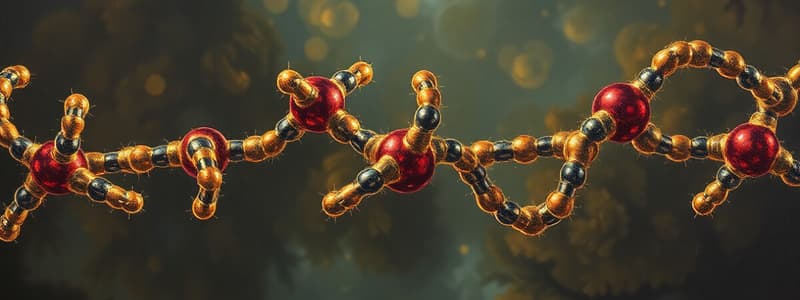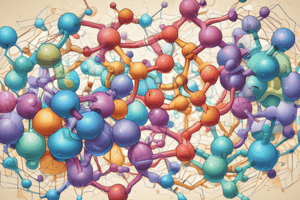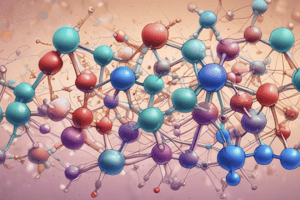Podcast
Questions and Answers
What is the pKa of the amino group at the N-terminus of a peptide?
What is the pKa of the amino group at the N-terminus of a peptide?
- 2.2
- 6.0
- 8.3 (correct)
- 3.5
At physiological pH, which side chains predominantly contribute a positive charge to a peptide?
At physiological pH, which side chains predominantly contribute a positive charge to a peptide?
- Arginine and lysine (correct)
- Tyrosine and histidine
- Aspartate and glutamate
- Cysteine and aspartate
At what pH does histidine predominantly exist in a positively charged form?
At what pH does histidine predominantly exist in a positively charged form?
- 8.0
- 7.4
- 6.0 (correct)
- 5.0
Which functional group has a pKa near 3.5 in the C-terminus of a peptide?
Which functional group has a pKa near 3.5 in the C-terminus of a peptide?
What does the net charge of a peptide at physiological pH assume regarding side chain pKa values?
What does the net charge of a peptide at physiological pH assume regarding side chain pKa values?
What type of reaction occurs during peptide bond formation?
What type of reaction occurs during peptide bond formation?
What happens to the amino acids during the formation of a peptide bond?
What happens to the amino acids during the formation of a peptide bond?
What term is used to describe the individual units in a polypeptide after peptide bond formation?
What term is used to describe the individual units in a polypeptide after peptide bond formation?
Which process is thermodynamically favorable under physiological conditions?
Which process is thermodynamically favorable under physiological conditions?
What must occur for peptide bond formation to take place in living cells?
What must occur for peptide bond formation to take place in living cells?
Why do peptide bonds remain intact for a long time despite thermodynamic favorability towards hydrolysis?
Why do peptide bonds remain intact for a long time despite thermodynamic favorability towards hydrolysis?
What is the result of adding a water molecule across a peptide bond?
What is the result of adding a water molecule across a peptide bond?
What is essential for peptide bonds to hydrolyze at a significant rate?
What is essential for peptide bonds to hydrolyze at a significant rate?
Why is the process of peptide bond formation considered endothermic overall?
Why is the process of peptide bond formation considered endothermic overall?
What characterizes the bonding in a peptide bond?
What characterizes the bonding in a peptide bond?
What geometric configuration do atoms involved in a double bond exhibit?
What geometric configuration do atoms involved in a double bond exhibit?
What effect does the partial double bond character have on peptide bond rotation?
What effect does the partial double bond character have on peptide bond rotation?
Which configuration do most peptide bonds adopt to minimize steric overlap?
Which configuration do most peptide bonds adopt to minimize steric overlap?
Which residue commonly causes peptide bonds to be found in either cis or trans configurations?
Which residue commonly causes peptide bonds to be found in either cis or trans configurations?
What primarily causes the restriction of conformations in peptides and proteins?
What primarily causes the restriction of conformations in peptides and proteins?
What is the effect of resonance in the amide group of a peptide bond?
What is the effect of resonance in the amide group of a peptide bond?
Which configuration do most peptide bonds adopt?
Which configuration do most peptide bonds adopt?
What are the ends of a dipeptide referred to as?
What are the ends of a dipeptide referred to as?
What happens to the amino and carboxyl groups during the formation of a peptide bond?
What happens to the amino and carboxyl groups during the formation of a peptide bond?
In which direction are amino acid sequences conventionally written?
In which direction are amino acid sequences conventionally written?
Which of the following peptides have distinct biological properties despite containing the same amino acids?
Which of the following peptides have distinct biological properties despite containing the same amino acids?
How do biological systems synthesize peptides?
How do biological systems synthesize peptides?
What is the configuration of peptide bonds preceding proline?
What is the configuration of peptide bonds preceding proline?
What does the term 'polarity' refer to in the context of peptides?
What does the term 'polarity' refer to in the context of peptides?
What effect can the arrangement of amino acid residues in a peptide have?
What effect can the arrangement of amino acid residues in a peptide have?
What is the consequence of forming a tripeptide from three amino acids?
What is the consequence of forming a tripeptide from three amino acids?
How many different ways can a tripeptide composed of one alanine (A), one arginine (R), and one glutamic acid (E) be arranged?
How many different ways can a tripeptide composed of one alanine (A), one arginine (R), and one glutamic acid (E) be arranged?
If all 20 proteinogenic amino acids can be used in a tripeptide of four residues, how many different arrangements are possible?
If all 20 proteinogenic amino acids can be used in a tripeptide of four residues, how many different arrangements are possible?
What is the term for the side of an amino acid residue closer to the N-terminus?
What is the term for the side of an amino acid residue closer to the N-terminus?
What distinguishes protease enzymes that cleave on the C-terminal side from those that cleave on the N-terminal side?
What distinguishes protease enzymes that cleave on the C-terminal side from those that cleave on the N-terminal side?
Which group in amino acids contributes to the ionizable properties of peptides?
Which group in amino acids contributes to the ionizable properties of peptides?
What is the pKa value of amino groups in free amino acid backbones typically near?
What is the pKa value of amino groups in free amino acid backbones typically near?
Which enzyme cleaves peptide bonds on the N-terminal side of aspartate?
Which enzyme cleaves peptide bonds on the N-terminal side of aspartate?
What primarily contributes to the diverse functions of peptides and proteins in living cells?
What primarily contributes to the diverse functions of peptides and proteins in living cells?
Which term describes the amino acid residues that do not have backbone amino or carboxyl groups?
Which term describes the amino acid residues that do not have backbone amino or carboxyl groups?
In order to carry out biochemical functions, what aspect of amino acids is crucial?
In order to carry out biochemical functions, what aspect of amino acids is crucial?
Flashcards
Peptide Bond
Peptide Bond
A chemical bond formed between the carboxyl group of one amino acid and the amino group of another amino acid, releasing a molecule of water.
Proteases
Proteases
Enzymes that break down proteins by hydrolyzing peptide bonds.
Hydrolysis
Hydrolysis
The process of breaking a chemical bond by adding water.
Exothermic vs. Endothermic
Exothermic vs. Endothermic
Signup and view all the flashcards
Partial Double Bond Character of Peptide Bonds
Partial Double Bond Character of Peptide Bonds
Signup and view all the flashcards
Planarity of Peptide Bonds
Planarity of Peptide Bonds
Signup and view all the flashcards
Restricted Rotation of Peptide Bonds
Restricted Rotation of Peptide Bonds
Signup and view all the flashcards
Trans Configuration of Peptide Bonds
Trans Configuration of Peptide Bonds
Signup and view all the flashcards
Cis Configuration of Peptide Bonds
Cis Configuration of Peptide Bonds
Signup and view all the flashcards
Peptide
Peptide
Signup and view all the flashcards
Hydrolysis of Peptide Bonds
Hydrolysis of Peptide Bonds
Signup and view all the flashcards
Condensation Reaction
Condensation Reaction
Signup and view all the flashcards
Amino Acid Residue
Amino Acid Residue
Signup and view all the flashcards
Thermodynamically favorable
Thermodynamically favorable
Signup and view all the flashcards
Kinetically stable
Kinetically stable
Signup and view all the flashcards
Amino Acid Sequence
Amino Acid Sequence
Signup and view all the flashcards
Amino Terminus (N-terminus)
Amino Terminus (N-terminus)
Signup and view all the flashcards
Carboxy Terminus (C-terminus)
Carboxy Terminus (C-terminus)
Signup and view all the flashcards
Trans Configuration (Z)
Trans Configuration (Z)
Signup and view all the flashcards
Cis Configuration (E)
Cis Configuration (E)
Signup and view all the flashcards
Peptide Backbone Flexibility
Peptide Backbone Flexibility
Signup and view all the flashcards
Cis-trans Isomerization
Cis-trans Isomerization
Signup and view all the flashcards
Factorial
Factorial
Signup and view all the flashcards
Protein Folding
Protein Folding
Signup and view all the flashcards
N-terminus and C-terminus
N-terminus and C-terminus
Signup and view all the flashcards
Peptide Bond Hydrolysis
Peptide Bond Hydrolysis
Signup and view all the flashcards
pKa of N-terminus
pKa of N-terminus
Signup and view all the flashcards
pKa of C-terminus
pKa of C-terminus
Signup and view all the flashcards
Acid-Base Properties of Peptides
Acid-Base Properties of Peptides
Signup and view all the flashcards
Isoelectric point of a peptide
Isoelectric point of a peptide
Signup and view all the flashcards
Zwitterionic Peptide Backbone
Zwitterionic Peptide Backbone
Signup and view all the flashcards
pKa Changes in Peptides
pKa Changes in Peptides
Signup and view all the flashcards
Predominant Net Charge of a Peptide
Predominant Net Charge of a Peptide
Signup and view all the flashcards
Net Charge Calculation
Net Charge Calculation
Signup and view all the flashcards
Study Notes
Amino Acids and Peptides
- Amino acids are the building blocks of polypeptides
- Polypeptides form when the amino group of one amino acid bonds with the carboxyl group of another, forming a peptide bond.
- A dipeptide is formed when two amino acids link together. A tripeptide results from three amino acids, and so on.
- Peptide bonds form through a condensation reaction, releasing a water molecule.
- Peptide bond formation is thermodynamically unfavorable under normal conditions, requiring energy input.
- Peptide bonds are kinetically stable, remaining intact for long periods, allowing them to perform their biological functions.
- Peptide bond hydrolysis is thermodynamically favorable, but slow due to a high activation energy. Enzymes like proteases are required for faster hydrolysis.
Peptide Bond Characteristics
- Peptide bonds exhibit partial double bond character, restricting rotation around the bond.
- The atoms involved in the peptide bond (C and N atoms) and adjacent atoms are coplanar.
- This planarity affects protein folding.
- The peptide bond typically exists in the trans configuration, minimizing steric clashes.
- Proline residues can adopt both cis and trans configurations.
Peptide Organization
- Peptides have an amino-terminus (N-terminus) and a carboxyl-terminus (C-terminus).
- Amino acid sequences are written from the N-terminus to the C-terminus.
- Peptides with different sequences, even using the same amino acids, have distinct properties.
- The sequence of amino acids in a peptide directly influences its structure and consequently, its function.
Peptide Properties
- The arrangement of amino acids can significantly affect the properties of a peptide.
- Different arrangements of the same amino acids lead to a substantial diversity in peptide properties.
- The number of possible arrangements from different amino acid combinations is extensive, increasing exponentially with the size of the peptide.
Peptide and Protein Properties
- Peptide properties depend on the arrangement of amino acid residues.
- Even small peptides can exhibit substantial diversity.
- The arrangement affects how peptides/proteins function.
- Specific arrangements determine the ability to participate in specific reactions or interactions.
Studying That Suits You
Use AI to generate personalized quizzes and flashcards to suit your learning preferences.




